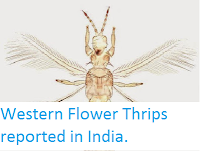Thrips (the word is both singular and plural),Thripidae, are very
small Insects with wings reduced to feathery growths (though this is sufficient
to support them in flying due to their small size). Flower Thrips, Frankliniella spp., are a large group of plant-feeding Thrips, predominantly found in the American Tropics, that feed by sucking fluids
from plants, and as such are important agricultural pests, both for their
ability to damage plants directly and their ability to act as a vector for
plant pathogens.
In a paper published in the journal Zootaxa on 9 February 2017, Arturo Goldarencena and Thierry Hance of the Earth and Life Institute Biodiversity Research Centre at the Université catholique de Louvian, describe a new species of Flower Thrips from the cloud forests of Coatepec in Veracruz State, Mexico.
The new species is named Frankliniella veracrucensis, meaning 'from Veracuz'. The species is described from three male and three female specimens gathered from the flowers of Mexican Bush Sage, Salvia leucantha, growing in cloud forests. The specimens are yellow in colour, and have seven segments to their antennae (most Flower Thrips have eight). A measured female specimen was 1295 μm in length, while a male was 1071 μm.
Frankliniella veracrucensis: (1) Habitus female; (2) Head and Pronotum female; (3) Antennal segment III female; (4) Antenna female; (5. Mesonotum and metanotum female. Goldarencena & Hance (2017).
See also...

Follow Sciency Thoughts on Facebook.





